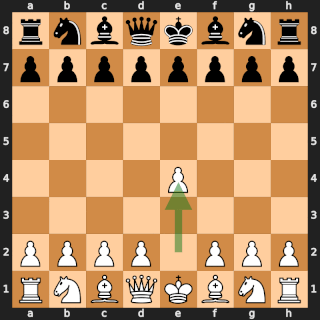
Castling is a move in the game of chess involving a player's king and either of the player's original rooks. It is the only move in chess in which a player moves two pieces in the same move, and it is the only move aside from the knight's move where a piece can be said to "jump over" another.

The French Defence is a chess opening characterised by the moves:

The Nimzo-Indian Defence is a chess opening characterised by the moves:

The Opera Game was an 1858 chess game played at an opera house in Paris, during Bellini's opera Norma, between the American chess master Paul Morphy and two strong amateurs: the German noble Karl II, Duke of Brunswick and the French aristocrat Comte Isouard de Vauvenargues. Duke Karl and Count Isouard consulted together, playing as partners against Morphy.

The Grünfeld Defence is a chess opening characterised by the moves:

The Sicilian Defence is a chess opening that begins with the following moves:

The King's Indian Defence is a common chess opening. It arises after the moves:

Grob's Attack is an unconventional chess opening where White immediately moves the king knight pawn two squares:

The Alekhine's Defence is a chess opening that begins with the moves:

The Damiano Defence is a chess opening beginning with the moves:
- e4e5
- Nf3f6?

The Modern Benoni is a chess opening that begins with the moves 1.d4Nf6 2.c4c5 3.d5e6. It is classified under the ECO codes A60–A79. After the initial moves, Black proceeds to capture on d5, creating a majority of black pawns on the queenside. To support their advance, the king's bishop is usually fianchettoed on g7. These two features differentiate Black's setup from the other Benoni defences and the King's Indian Defence, although transpositions between these openings are common.

The Budapest Gambit is a chess opening that begins with the moves:

The King's Pawn Game is any chess opening starting with the move:

In chess, an isolated pawn is a pawn that has no friendly pawn on an adjacent file. Isolated pawns are usually a weakness because they cannot be protected by other pawns. The square in front of the pawn may become a good outpost or otherwise a good square for the opponent to anchor pieces. Isolated pawns most often become weaker in the endgame, as there are fewer pieces available to protect the pawn.

The Torre Attack is a chess opening characterized by the moves:

Larsen's Opening is a chess opening starting with the move:

The King's Indian Attack, also known as the Barcza System is a chess opening system for White, characterized by several moves. The center pawns are developed to e4 and d3, the knights are developed to d2 and f3, the king's bishop fianchettoes at g2 following the g-pawn's movement to g3, and White castles kingside. The resulting arrangement has multiple positional themes: the pawn at d3 and the knight at d2 both defend the pawn at e4, the knight at f3 attacks the center, the fianchettoed bishop may influence the center following subsequent moves, and castling removes the king to safety while bringing a rook into the game.

In chess, the Scheveningen Variation of the Sicilian Defence is an opening that is a line of the Open Sicilian characterised by Black setting up a "small centre" with pawns on d6 and e6. There are numerous move orders that reach the Scheveningen; a common one is:

In chess, the Dragon Variation is one of the main lines of the Sicilian Defence and begins with the moves:
In chess, the pawn structure is the configuration of pawns on the chessboard. Because pawns are the least mobile of the chess pieces, the pawn structure is relatively static and thus largely determines the strategic aspect of the position.


